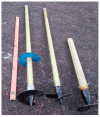Vertical Fiberglass Micropiles as Soil-Reinforcing Elements
- PMID: 35407923
- PMCID: PMC9000301
- DOI: 10.3390/ma15072592
Vertical Fiberglass Micropiles as Soil-Reinforcing Elements
Abstract
This article is dedicated to developing a ground improvement technique using vertically oriented reinforcement elements prefabricated utilizing fiberglass pultruded pipe and helical shape wideners at the bottom toe. Structures of the prefabricated helical micropiles varied by the length and cross-section area introduced into the soil massive as reinforcing bearing elements. The effect of the reinforcements geometry variation was investigated through a reinforcement factor (µ), based on which a calculation method for measuring settlement of reinforced soil has been previously developed Full-scale field plate load tests were performed before and after reinforcing the soil to investigate the changes in the soil stiffness after the reinforcement process. Comparative analysis between the reinforced and reference soft sandy soil indicates an average increase in the deformation properties of the fiber reinforced soils by 8%, 30%, 63% at the applied pressures of 100, 300, and 550 kPa, respectively. The influence of the fiber reinforced polymers (FRP) geometrical properties on the final composite settlement was determined. A comparative analysis of the calculated and the actual plate load tests results reveals that the previously proposed settlement calculation method is adequate for further development.
Keywords: FRP pile; deformation; fiber-reinforced composite; fiberglass; screw micropile; soil reinforcement; vertical reinforcement.
Conflict of interest statement
The authors declare no conflict of interest.
Figures











References
-
- Sabri M., Bugrov A., Panov S., Davidenko V. Ground Improvement Using an Expandable Polyurethane Resin; Proceedings of the MATEC Web of Conferences EECE-2018; Saint-Petersburg, Russia. 19–20 November 2018.
-
- Sabri M.M., Shashkin K.G. The mechanical properties of the expandable polyurethane resin based on its volumetric expansion nature. Mag. Civ. Eng. 2020;98:9811. doi: 10.18720/Mce.98.11. - DOI
-
- Usmanov R., Rakočević M., Murgul V., Vatin N. Problems of Sub-Mountain Area Development Associated with Collapsing Loess Soils (Case of Tajikistan) Appl. Mech. Mater. 2014;633–634:927–931. doi: 10.4028/www.scientific.net/AMM.633-634.927. - DOI
-
- Sabri M.M., Shashkin K.G. Improvement of the soil deformation modulus using an expandable polyurethane resin. Mag. Civ. Eng. 2018;83:222–234. doi: 10.18720/Mce.83.20. - DOI
Grants and funding
LinkOut - more resources
Full Text Sources
Miscellaneous

